#dobsonfly larva
Text
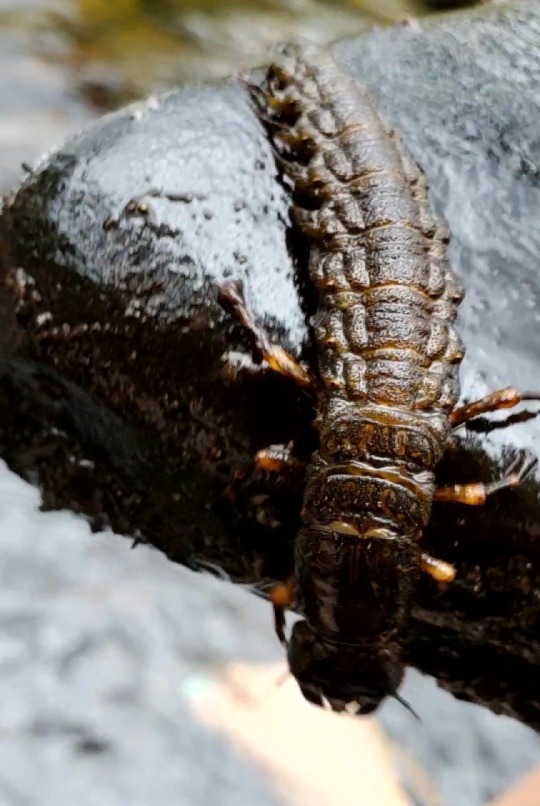
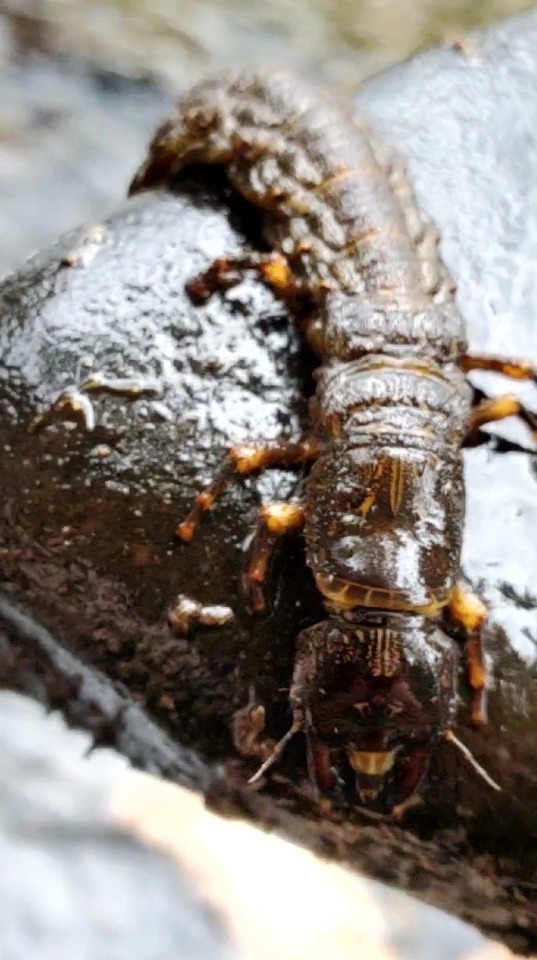
Eastern dobsonfly (Corydalus cornutus) larva I found while hanging out in the river in Northeastern Pennsylvania (US) last year.
Dobsonfly larvae, also known as hellgrammites, are one of the top invertebrate predators in fast-moving streams. They tend to hide under rocks and use their sharp mandibles to capture and eat prey. These mandibles can also deliver a painful (but harmless) bite, so definitely be careful handling them!
Larvae can get up to 3.5 inches (9 cm) long. Since they're large and relatively common, many of the local fishermen like to use them as bait (which may or may not be problematic).
These insects spend 1-3 years as larvae and pupate outside of the stream under a rock or log. The adults are huge. The male can be up to 5.5 inches (14 cm) long and has massive mandibles that are intimidating but harmless. Adults aren't known to feed, and they only live for about a week, just enough time to mate and lay eggs.
#dobsonfly#dobsonfly larva#hellgrammite#bug#Corydalus cornutus#Corydalidae#Megaloptera#eastern dobsonfly#nature#bugs#biodiversity#animals#inaturalist#arthropods#bugblr#entomology#insect appreciation#creature#invertebrates#aquatic life#pennsylvania#river#predator#nature appreciation#cool facts#biology#science#interesting
18 notes
·
View notes
Photo
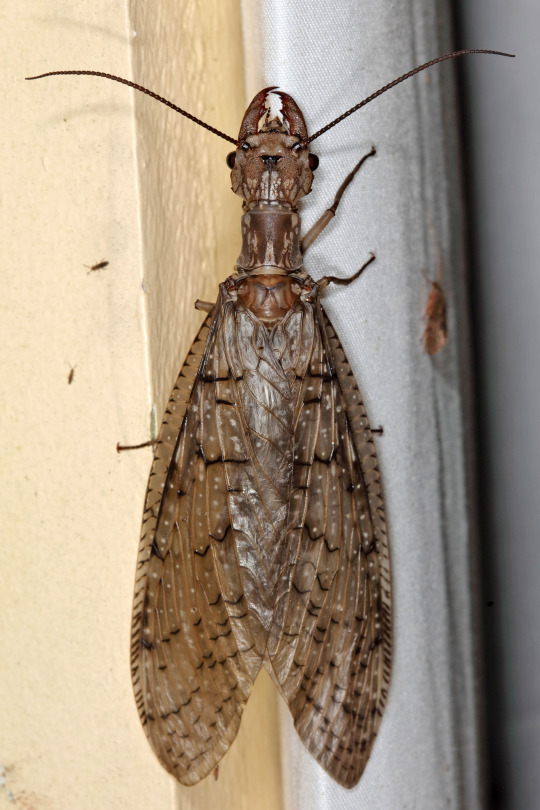
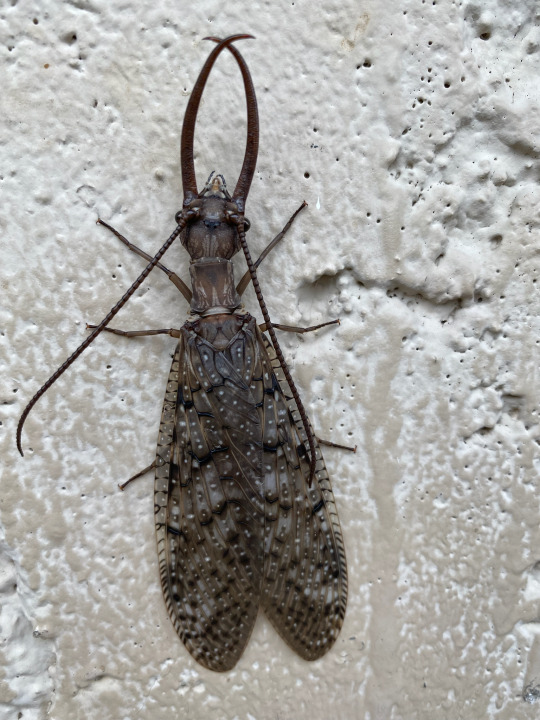
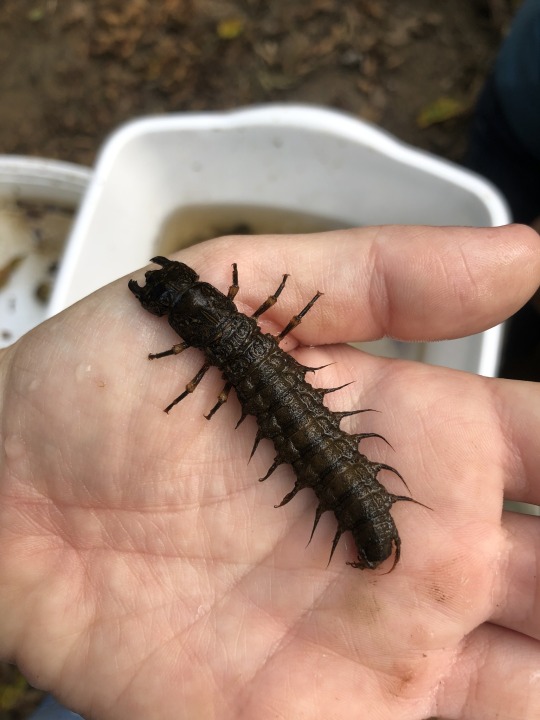
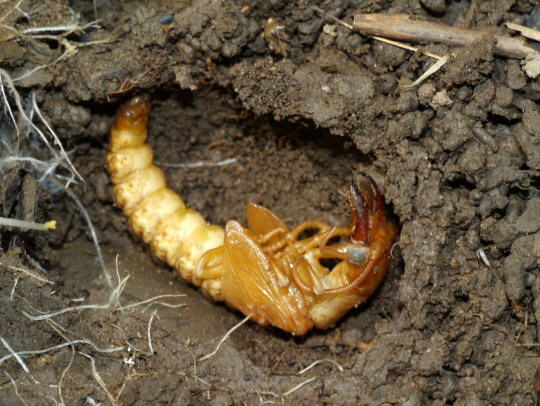
Eastern dobsonfly, Corydalus cornutus, Corydalidae
Found throughout the eastern United States and up into Canada.
Photo 1 (adult female) by tmurray74, 2 (adult male) by togatiya, 3 (larva - aka hellgrammite) by kellysmith, and 4 (pupa) by muir
#animals#insects#curators on tumblr#bugs#dobsonfly#eastern dobsonfly#larva#hellgrammite#pupa#one nice bug
656 notes
·
View notes
Text
when i was in like middle/high school i had this pov of "why would someone not choose to work in a field that theyre incredibly good at" and the answer is i dont want to write literary analysis i want to look at trees. i think literature and lit analysis is incredibly important and i know i am a gifted writer but theres trees out there
#my prof repeatedly and very passionately telling me i would do very well with an english major vs me almost crying w joy over#holding dobsonfly larvae while water quality testing
38 notes
·
View notes
Text
Wet Beast Wednesday: aquatic insect larvae
This Wet Beast Wednesday is going to be different than usual. Instead of an in-depth overview of a specific species or group of species, I'm going to give a general overview of aquatic insect larvae as a whole and then showcase some groups of insects. I'm going to focus on insects that have an aquatic larval stage and terrestrial adult stage, saving adult aquatic insects for another post.
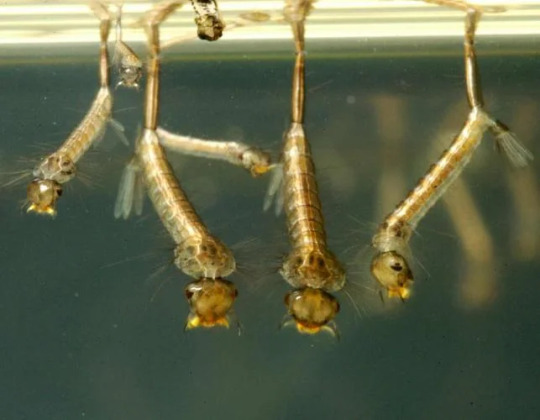
(Image ID: a group of mosquito larvae. They are yellowish bugs with long, slender bodies, no visible limbs, small heads, and feathery appendages from their rear ends. From the back of the abdomen, a snorkel-like appeadage attaches to the surface of the water, using surface tension to allow the larvae to hang from the surface. End ID)
Insects are basically the most successful group of animals in the history of life on Earth and have adapted to live in just about every terrestrial habitat. It should not be much of a surprise than that they have also moved into the water. More specifically, fresh water as almost all aquatic insects inhabit fresh or maybe brackish water. Only the water strider genus Halobates are truly marine. Some species of insect are aquatic for their entire lives, some are primarily terrestrial but able to swim, and some are aquatic only for their larval stage of life. These aquatic larvae species are generally agreed to have evolved from fully terrestrial ancestors. The adaptation of partially returning to the water has evolved independently many times in many different clades of insect and so different species use different strategies and adaptations. It is possible that aquatic larvae evolved in response to high competition for resources on land. If multiple species are competing over the same resources during their larval stages but one of those species manages to adapt to a whole new environment, that species will now have abundant access to resources the other species are unable to get to. Because of the very different lifestyles required for aquatic and terrestrial animals, aquatic larvae often look very different than their adult forms.
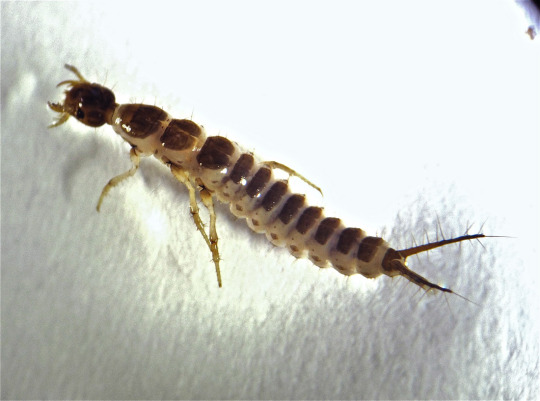
(Image: an aquatic beetle larva. It looks nothing like an adult beetle, instead being a long, slender insect with no wings, multiple body segments, and two hairy appendages at the base of the abdomen. End ID)
Aquatic larvae serve important roles in their ecosystems. Many are herbivores or detritivores that consume algae and bits of biological material, helping recycle nutrients and clean the water. Some are predators that hunt smaller invertebrates or plankton. Importantly, aquatic insect larvae provide a major food source for larger fish, invertebrates, birds, and so on. Some species can be considered keystone species, vital to their ecosystems. Many species are highly sensitive to changes in their environment, allowing them to act as indicator species for the health of their ecosystems. The trio of mayflies, stoneflies, and caddisflies are very commonly used as indicators of pollution as all three are highly sensitive to pollutants. A stream with few mayflies, stoneflies, or caddisflies but plenty of less sensitive species is likely to be polluted.
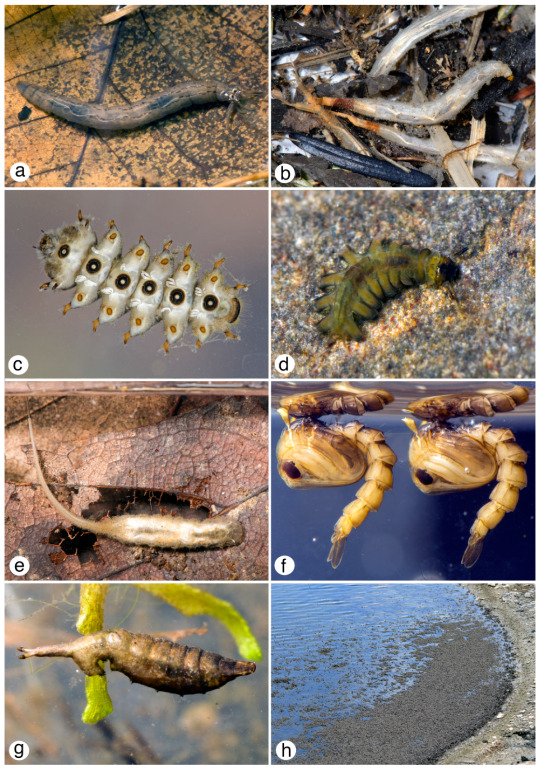
(Image ID: a collage of aquatic larvae of multiple species in the order Diptera (true flies. They vary from slug-like to having multiple distinct body segments with legs, to looking like maggots with long tails. End ID. Source)
Mayflies (order Ephemeroptera) are among the oldest lineages of winged insects, bearing traits that they first flying insect also had. Juvenile mayflies are technically not larvae, but nymphs. The difference between a larva and a nymph is that nymphs look much more like the adult stage than larvae do. Mayfly nymphs lack the wings of adults, but have external gills growing from the sides of their abdomens. Mayfly nymphs can be identified by three appendages called cerci that emerge from the back of the abdomen. They are bottom-dwellers that typically live under rocks and other objects or amid plants. Most are herbivores, feeding mainly on algae. Months to years after hatching (species dependent), mayflies will float to the surface and go through a molt to a stage called the subimago. Uniquely among insects, mayflies go through two final winged molts. The first is to a not sexually mature stage called the subimago, then they quickly molt again into a fully mature imago stage. These molts happen in sync, resulting in hundreds to thousands of mayflies appearing all at once and swarming together to mate. Famously, adult mayflies exist only to mate and die. Their digestive systems are non-functional and few species last past a few days.
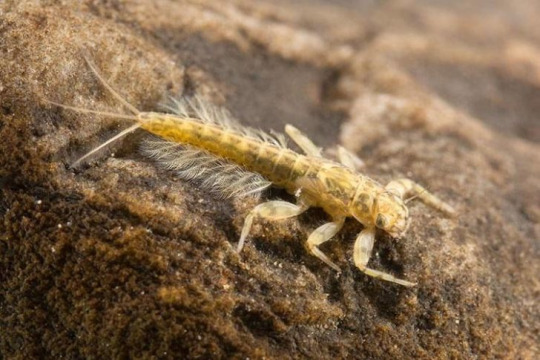
(Image: a mayfly nymph on a rock. It is a yellow bug with no wings, a long abdomen, and thick, grasping legs. Three long, hairy cerci emerge from the back. Along the side of the abdomen are multiple pairs of white, feathery gills. End ID)
Stoneflies (order Plecoptera) also have nymphs and can be quite difficult to tell apart from mayfly nymphs if you don't know what to look for. One of the biggest differences is that their gills are located by the base of the legs rather than along the abdomen. Like mayflies, stoneflies are some of the most primitive winged insects, but mayflies are Paleopterans (the earliest wings insects) while stoneflies and most other winged insects are Neopterans. The main difference is that Neopterans can flex their wings over their abdomens while Paleopterans cannot, and must hold their wings either out to the side or up in the air. Like with Mayflies, many adult stoneflies have nonfunctional digestive systems and exist only to mate and die.
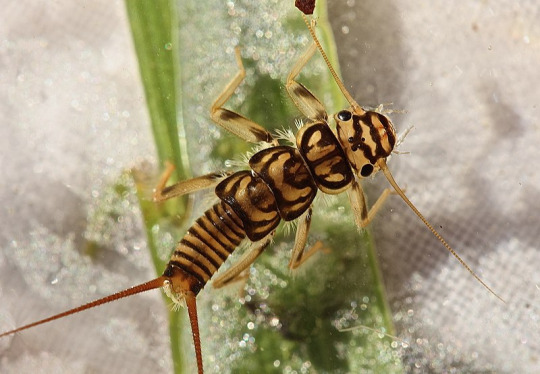
(Image: a stonefly larva. It looks similar to a mayfly larva, but has a shorter abdomen, gills along the base of the legs, and only two cerci. End ID)
Caddisflies (order tricoptera) are the builders of the aquatic insect world. These larvae (most species anyway) can produce silk from glands near their mouths. These are used to make a variety of structures made from silk and various other materials including sand, silt, plant parts, shells, rock, and so on. Different species will seek out specific materials for their structures. There are a few types of structures, the most common of which is a tubular case that is open at both ends. The larva can carry the case with it as it crawls around and can retreat into the case for protection. The larva can draw water into one end of the case and out the other, allowing oxygenated water to flow over the gills. By moving around in the case, the larva can draw in more water. This allows the larvae to survive in water that is too oxygen-poor for other larvae. Other species build different structures including turtle-shell like domes or stationary retreats. My favorite structures are nets built with an open end into current. The current naturally brings detritus and micro-invertebrates into the net, where the larva can eat them. Caddisflies also pupate into pupa that have mandibles to cut their way out of their cases and swimming legs. Once developed, the pupae swim to the surface and molt into their adult forms. This molting is synchronized to ensure the adults emerge in swarms and can easily find mates.
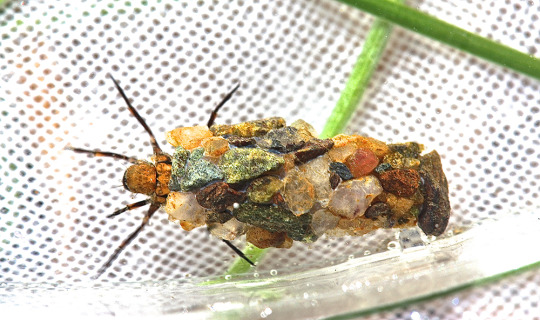
(Image ID: a caddisfly larva in its case. The case is a tube composed of pebbles of different colors stuck together with silk. The head and legs of the larva are merging from the front of the case. End ID)
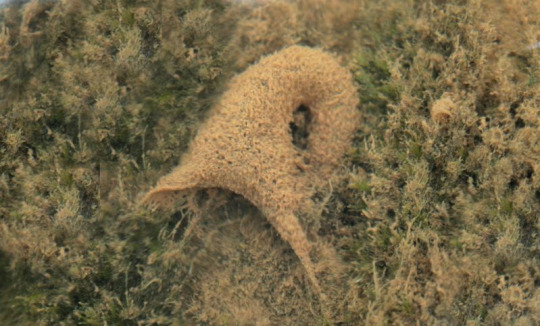
(Image: a caddisfly net. It is a structure made of silk shaped like a tube that is wide at one end and tapers toward the other. It is curved so both ends face the same way. End ID)
The order Megaloptera consists of alderflies, dobsonflies, and fishflies. All three have aquatic larvae, but their eggs are laid on land. Most species lad their eggs on plants overhanging the water so the larvae fall in once hatched, though a few lay eggs near the water's edge, forcing the larvae to crawl in. Meglaoptera have the least amount of differences between larva and adult of all holometabolous (pupa-forming) insects. The largest differences between the larvae and adults is the larvae lack wings and some species have leg-like prolegs. All species are carnivorous as larvae and feed on other invertebrates.
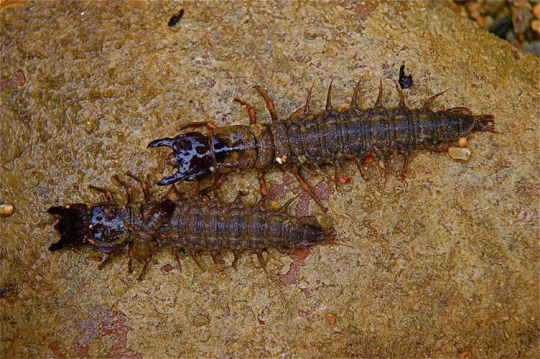
The adults don't look any less creepy
(Image: two hellgrammites, the larval form of a dobsonfly. It looks somewhat like a centipede with three pairs of limbs and a long abdomen with multiple pairs of leg-like prolegs. The head has no visible antennae, but does have a pair of powerful pincers. End ID)
Order Odonata consists of dragonflies and damselflies. These are powerful predators both as nymphs and adults. As nymphs, the juveniles are shorter and stockier than the adults, with no wings. The nymphs (or naiads) breathe through gills. In damselflies, these gills can be external, but dragonfly nymphs have their gills located in the anus. Damselflies can swim by undulating their gills, but dragonfly nymphs are restricted to crawling. The nymphs are voracious predators that will feed on anything they can catch. Most of their diet consists of invertebrates, but they will also attack small fish, tadpoles, and even salamanders.
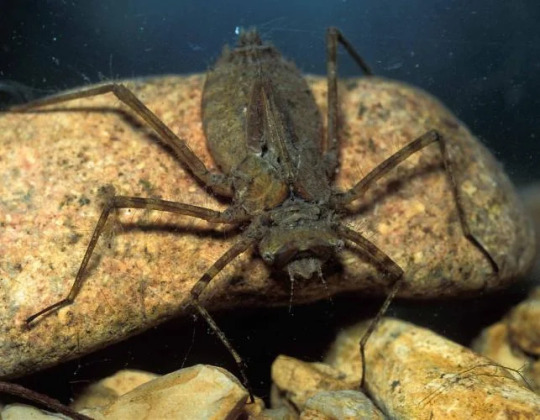
(Image ID: a dragonfly larva on a rock. Its head is similar to that of the adults, but the abdomen is much shorter and broader and the legs are longer. It has no wings and is brown all over. End ID)
The groups of insects I covered today (plus the stoneflies) all have exclusively or near-exclusively have aquatic larvae while the adults are terrestrial. In other groups, aquatic larvae may be present in some species while others have terrestrial larvae. For example, a great many members of the order Diptera (true flies) have aquatic larvae including all mosquitos, while other members of the order have fully terrestrial larvae. In addition there are species of beetle (order Coleoptera), moth (order Lepidoptera), lacewing (order Neuroptera), and scorpionflies (order Mecoptera) that have aquatic larvae and some species of the true bugs (order Hemiptera) have aquatic larvae and aquatic adults, including water skaters, water scorpions, and giant water bugs. Aquatic insects are so prevalent that it is rare to find any lasting body of water that doesn't host some aquatic larvae or adults. Even incredibly stagnant and filthy water can host aquatic insect larvae, as shown by the notorious rat-tailed maggots, who love stagnant water and breathe through snorkels. Many species require very specific conditions and there are species of insect who exclusively grow their larvae in specific streams or lakes. Because of this, conservation of these bodies of water is vital to their survival and pollution, damming, and other factors can destroy whole species.
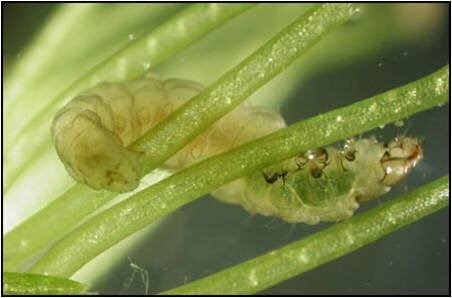
(Image: an aquatic moth larva. It looks very similar to a green land caterpillar, with none of the fancy elements many land species have. It is translucent and wrapped around some aquatic plant stems. End ID)
#wet beast wednesday#insects#insect larvae#aquatic insect larvae#larva#pupa#mayfly#stonefly#caddisfly#dobsonfly#hellgrammite#dragonfly#damselfly#freshwater ecology#ecology#biology#zoology#invertebrate#invertebrates#animal facts#informative#bug#bugs
38 notes
·
View notes
Text
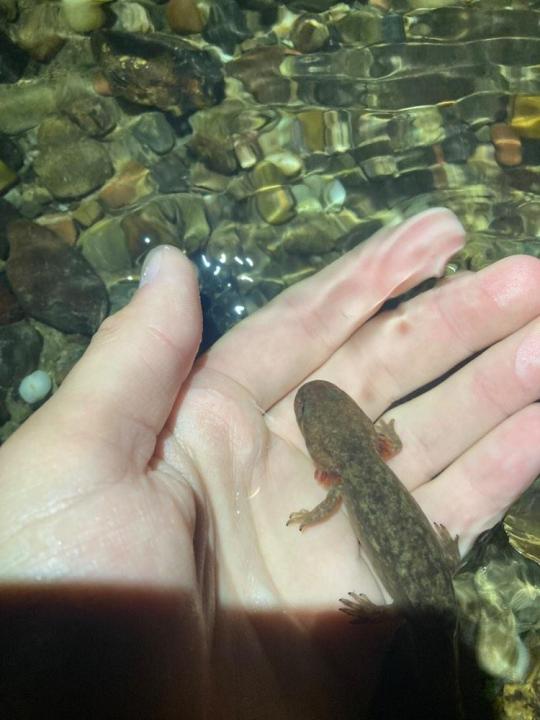

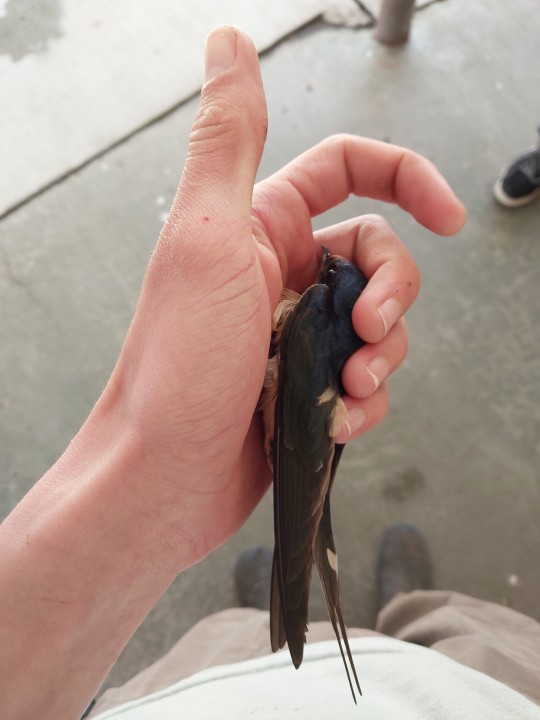
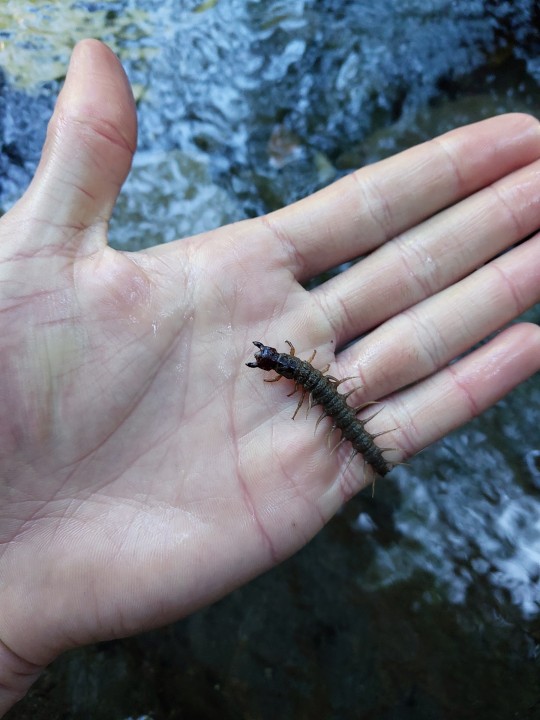
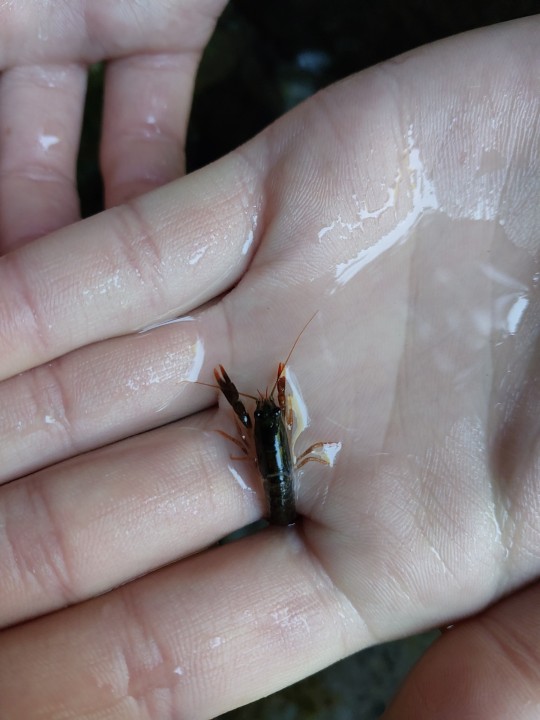
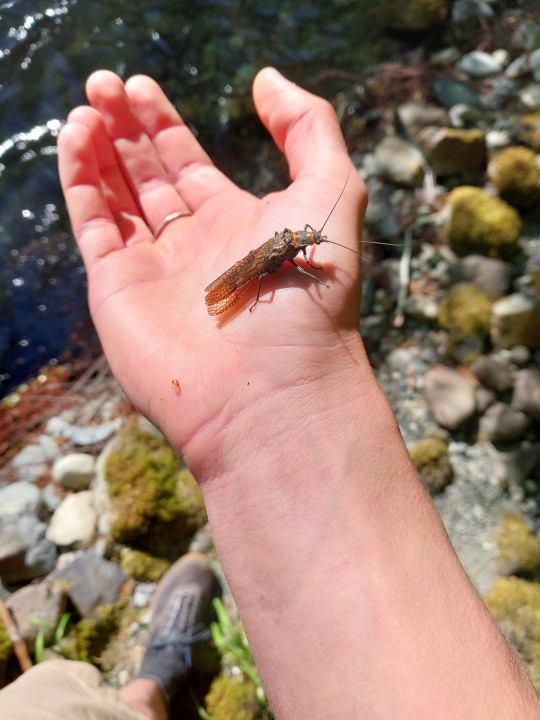
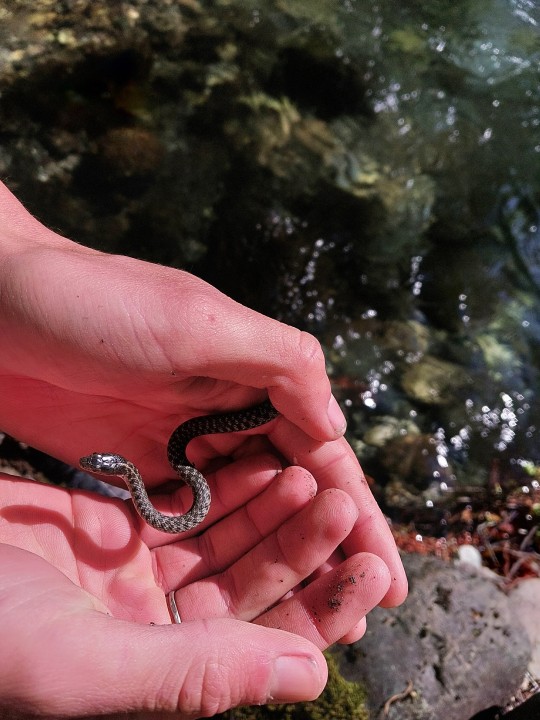

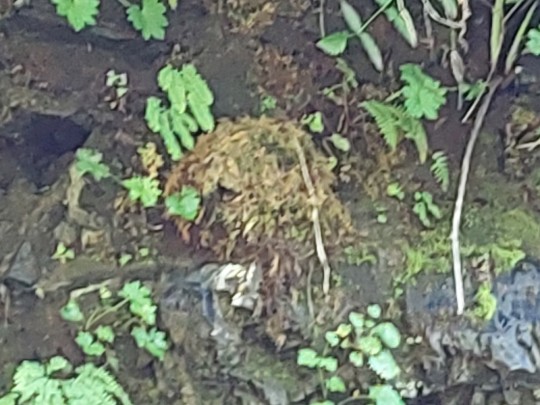
fFucking creatures post
fun fact theres no picture here of the American Dipper (bird) but the last picture is of its nest- dippers are so sick they can like jump into fast-moving streams and angle their wings downward to use the water pressure to hold them at the bottom while they walk along and look for aquatic arthropods
also any time they are standing around they kind of like... bounce??? like theyll sort of bend and unbend their knees and just do a little pop squat every couple seconds
extremely good bird
#salamander#salamander larva#dicamptodon#i think#lamprey#a fucking lamprey#barn swallow#i caught a bird with my hand#hellgrammite#is the coolest name ever#aquatic insects#dobsonfly#crawdad#i refuse to call it a crayfish just like i refuse to call sea stars starfish#yabbie is acceptible#stonefly#garter snake#of some sort#bee#that landed on my arm while i was posting this#american dipper#bird nest#its like a little cave built out of moss????
0 notes
Text


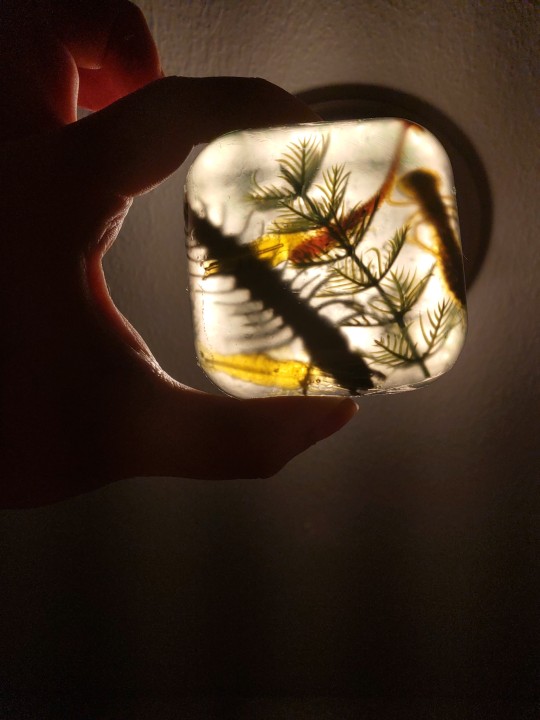
Okay this is currently just plain unscented glycerin soap with some coloring but here's my first experimental pond life soap bar, as you use it up you get a fake plant and rubber freshwater invertebrates (originally fishing lures, all their oil and scenting washed off) currently representing freshwater shrimp, a leech, a dragonfly nymph and a hellgrammite (dobsonfly larva) though I have some more varieties coming.
Looking into scent oils that might smell suitably swampy but haven't found much yet.
I might print a little fact sheet about each species represented and pack that in with them if I sell these.
390 notes
·
View notes
Note
what is your favorite aquatic invertibrate?
THIS is a loaded question. I've kept this in my inbox for a while cause there's SO MANY it's hard to choose. I'm most interested in mollusca and crustacea but those are still large categories.
My favorite mollusk is Dirona albolineata, the frosted alabaster nudibranch. Absolutely gorgeous and come in my favorite color.
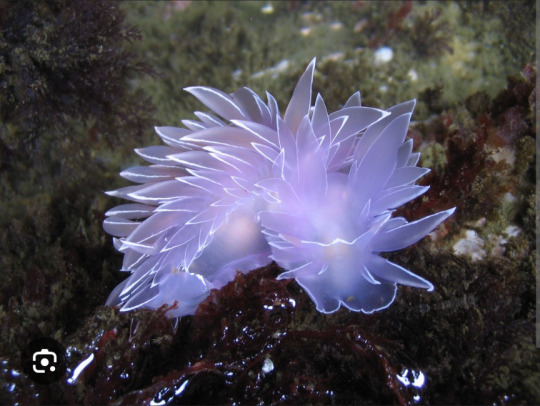
I pretty much love all nudibranches though. My second favorite would have to be sea butterflies, they're so weird!

And of course the animal crossing famous Clione limacina or sea angel
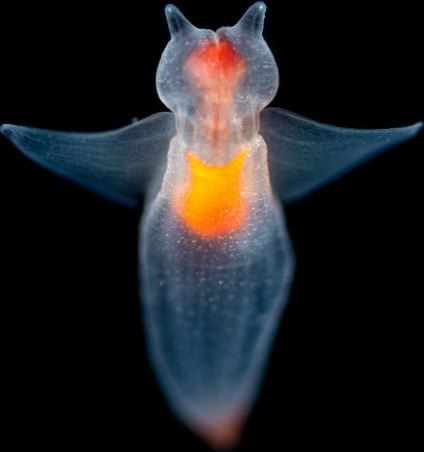
Academically, I'm currently researching freshwater mussels for our reintroduction project. Mussels may not be as flashy as nudibranchs, but they are extremely important for improving water quality in freshwater habitats. It's hard to choose a favorite, but one I've researched the most and have grown fondly of is Alasmidonta varicosa, the brook floater. We are hoping to eventually reintroduce it to it's previous native range. Fun fact, when you pick them up out of the water, they stick their "tongue" (foot) out.
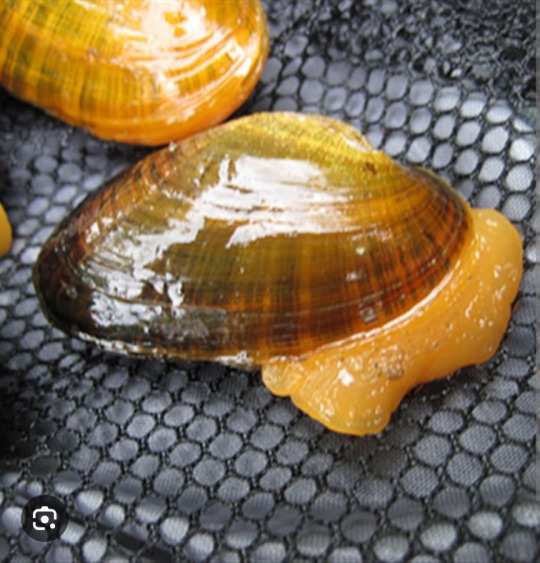
I literally had the species name written on my giant whiteboard in the office for a few months so my boss would keep seeing it since I really wanted us to use it as a flagship species to design our reintroduction project around. Fast forward and we've gotten a grant and things are progressing nicely.
Anyway on the crustacea side that's an even harder choice. I'm always excited to see aquatic isopods and scuds. I'm probably most fond of Malacostraca (amphipods, isopods, decapods, etc.) and Branchiopoda (clam, fairy, and tadpole shrimp, and water fleas). Do not make me pick one I am unable to. I will say I have a particular soft spot for crayfish as they are the organisms I've had the most one-on-one time with (I literally have a pet crayfish named Mr Pinchy). I just love anything with pinchers (ʃƪ^3^)≧〔゜゜〕≦

First crayfish I ever held doing it's little defensive stance of Shake Em Like You Just Don't Care. Just take a look at it's mouth! The mouthparts are so cool! I love watching Mr. Pinchy eat.
My favorite macroinvertebrate would hands down be Corydalus, aka Hellgrammites, which are the larval form of Dobsonflies. I have yet to see an adult dobsonfly in person, but have been told they're terrifying and not very nice. We shall see about that. Hellgrammites are simply angry pathetic overdramatic babies and while people say they bite I've held plenty and never been bit. They will absolutely go for the other bugs in the tray so you do have to keep them in a separate container. We've lost a couple of caddisfly larvae to the jaws of the mighty hellgrammite.
Just look at it! Here's a video where I'm trying to get a good shot of it's gills (those frilly things on its underside). They roll into a defensive ball which is so endearing. I also love anything that can curl into a ball. I think they're absolutely adorable but most people tend to disagree with me ಥ‿ಥ
TDLR I love all aquatic invertebrates so very much. I didn't even get into shrimp or coral or starfish! They make me so happy I actually have to limit how much I read about them in a day because my emotions get too big and cause me to become hyper (which is a bad combo for fibromyalgia). I'm not great at remembering information so I get to constantly relearn and rediscover things which is a blessing and a curse. This also makes taxonomy especially hard for me so let me know if I messed up somewhere.
10 notes
·
View notes
Text
December 13th, 2023

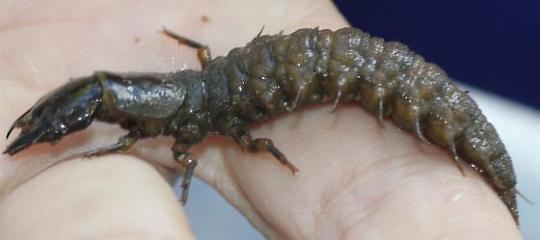
Eastern Dobsonfly (Corydalus cornutus)
Distribution: Found throughout eastern North America, from Canada down to Mexico.
Habitat: Found in or near fast-flowing, unpolluted rivers and streams; larvae live on the stream bottom, while adults are terrestrial (though remain around bodies of water).
Diet: Larvae are active predators, feeding on small invertebrates such as insects, other arthropods, molluscs and worms; preference for the larvae of blackflies, caddisflies and mayflies. Adult females feed on nectar, while males are not known to feed.
Description: Eastern dobsonflies are large, solitary insects. Their most obvious characteristic is the males' oversized mandibles, which can reach up to half the length of its body. Despite the adults' fearsome appearance, however, they're quite harmless. Larvae, however, have powerful mandibles and the capacity to deliver a painful bite.
Dobsonfly larvae, also known as hellgrammites, are commonly used as bait for fishermen. They're important predators of invertebrates in stream ecosystems, and are a natural enemy of blackflies. In habitats where fish are small or absent, large hellgrammites may be the largest predator in the water.
(Images by Kailyn Lianne Liu (adult) and Even Dankowicz (larva))
8 notes
·
View notes
Note
Do all arthropods regrow lost limbs upon a moult?
I accidentally caused a small camel cricket to lose its antennae and back leg when I put it in a jar with a dobsonfly larvae(didn't know what it was or how it behaved at the time). I'm hoping it can regrow it's lost parts if I keep it in my isopod jar with some fresh greens for a while.
I just wanted to test my homemade bug sucker I didn't mean to maim the poor creature
all of the camel crickets I’ve kept have shown no ability to regenerate limbs, and limited ability to regenerate antennae. if yours is very small, then maybe it has a chance to? don’t think I’ve raised an individual with autotomized limbs from less than instar 4. if not, then they often thrive quite well even in the wild missing a few parts
34 notes
·
View notes
Text

it's her adventure backpack :T
from this study done to measure daily movements of dobsonfly larvae (hellgrammites!) in the genus neohermes. turns out they BARELY get around, never during the day and only sometimes at night. makes sense for ambush predators.
this study also believes it to be the first to use radio telemetry on insects, is that true??
3 notes
·
View notes
Text


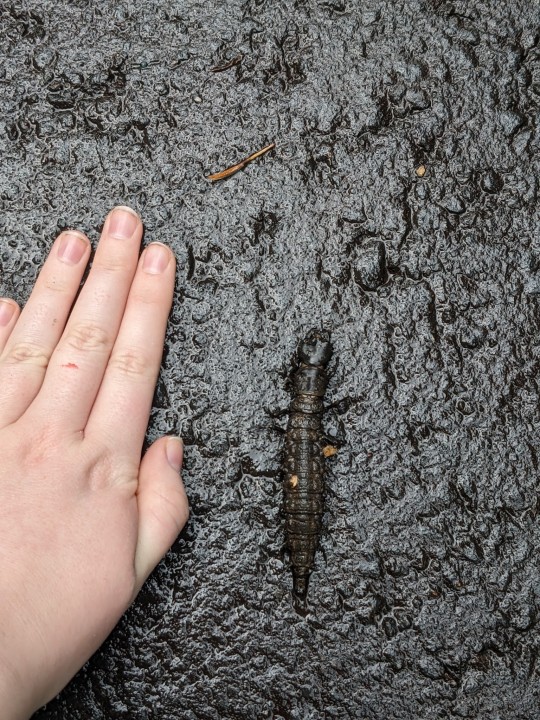
@schrodingers-cate submitted: Hi again, from [removed] (remove please)! Heres another lovely set of bugs ive been collecting pictures of. Im really interested in the ID for these, ESPECIALLY the really large larva . He was so big i spotted him from a second story window of the house next to the driveway he was crawling on. If it helps, that larva was right next to a small creek on a rainy day. Thanks so much!!
Great group of weird pals! The beetle is an oak timberworm weevil and the green fellow looks like a crane fly in the genus Erioptera, mayyyyybe Erioptera chloroplylla. The big larva is a dobsonfly! They’re aquatic as larvae, but leave the water to pupate :)
#animals#insects#bugs#submission#beetle#weevile#oak timberworm weevil#fly#diptera#crane fly#Erioptera#Erioptera chlorophylla#dobsonfly#eastern dobsonfly#larva
85 notes
·
View notes
Text
20 notes
·
View notes
Photo


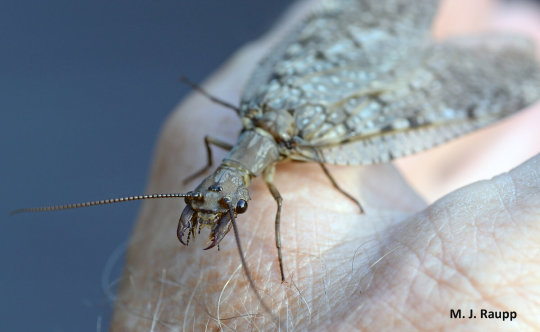
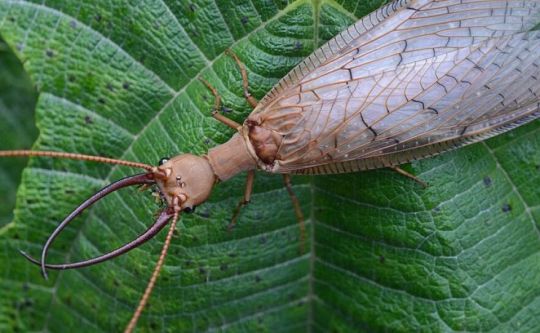
Darling Eastern Dobsonflies
requested by @skyroller
Eastern dobsonflies (Corydalus cornutus) is a distinct species of insect commonly found in the eastern rivers of North America. They go through several stages over the course of their lives, which in total can last as long as three years. They begin as eggs, laid close to water in clusters of up to 1,000. These clusters often resemble bird droppings as a form of camouflage. About a week or two after being laid, the eggs hatch into the form they spend most of their lives in-- the larvae known as hellgrammites.
Hellgrammites are aquatic, spending most of their time under river rocks. Over the course of 1-3 years, these larvae can molt up to 12 times. In late spring or early summer they finally emerge from the water, burrow into the soft soil of the river’s edge, and pupate. In colder regions C. cornutus remains dormant throughout the winter, but in warmer regions adults emerge after only 1-2 weeks. Male adults use their powerful jaws to fight each other for access to females, and after successfully mating both males and females die.
Larval C. cornutus have dark brown or black segmented bodies with 3 pairs of legs. Protruding from each segment is a filament with a gill tuft at the base, which they use to breathe under water. In addition to these, hellgrammites have a set of external respiratory openings called spiracles, with which they can also breathe on land. Adult dobsonflies look significantly different. The abdomen, while still segmented, is lightened to a tan and becomes more elongated; in total they can be up to 14cm long. The filaments are gone, replaced with 2 sets of large wings, which reach spans of 13cm. Adults also have a pair of antennae, which they can use to locate the chemical signals emitted by potential mates. Male C. cornutus sport a large, curved set of mandibles, which make up almost half their body length.
Because adult dobsonflies die soon after mating, they don’t eat. Hellgrammites, however, consume a wide range of smaller insects and larvae, mollusks, and crustaceans, making them important low-level predators in their native rivers. Both larvae and adults host a large number of predators including fish, crayfish, birds, and bats. Hellgrammites are also a popular choice of bait for fishermen. To protect themselves from predators, larvae and adults have mandibles that can deliver a powerful bite. They are also active primarily at night to avoid diurnal predators.
Conservation status: The eastern dobsonfly has not been evaluated by the IUCN. However, over collection for fishing may deplete populations, and larval dobsonflies are vulnerable to river pollution and deplition.
Photos
Jim Rathert
Isaac Szabo
Michael Raupp
Geoff Gallice
#eastern dobsonfly#Megaloptera#Corydalidae#dobsonflies#insects#arthropods#freshwater fauna#freshwater arthropods#rivers#river arthropods#deciduous forests#deciduous forest arthropods#North America#eastern north america#animal facts#biology#zoology#requested
66 notes
·
View notes
Note
Tell me about the dobsonflies please
Cool facts about the majestic dobsonfly!!
- If you’ve heard the term “Hellgrammite” before, that’s actually referring to larval dobsonflies.
- they exhibit sexual dimorphism in their mandibles. Male dobsonflies have long mandibles used for attracting a mate, while female dobsonflies have shorter mandibles that they use for biting.
- they can grow to be quite large, ranging from 3-4 inches (~7-10 cm) in length. Their wingspan ranges from ~7-8 inches (~18-21 cm)
- they can be yellow. This is very important.
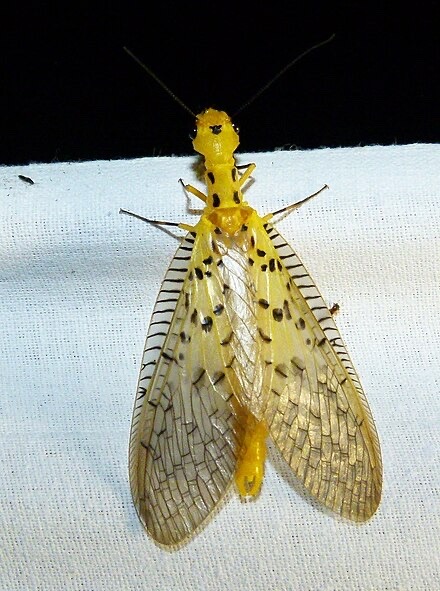
Nevromus austroindicus Liu & Viraktamath, 2012. From Mudigere, India.
- Acanthacorydalis fruhstorferi, a species of dobsonfly, is the largest aquatic insect in the world.
- The adults only life a week or so, but are very majestic while they do so. If you live in an area with dobsonflies, keep an eye out for them during the spring and summer months, and for their larvae in rivers, who are significantly less majestic but still wonderful beings.
2 notes
·
View notes
Note
Where did the dobson from dobsonfly come from?
No one knows! Apparently its oldest known use was a book in 1897 but it offered no explanation at all. The name "hellgrammite" for their larvae is equally mysterious. The origins of a lot of animal and plant common names are totally forgotten sadly
123 notes
·
View notes
Link
9 notes
·
View notes